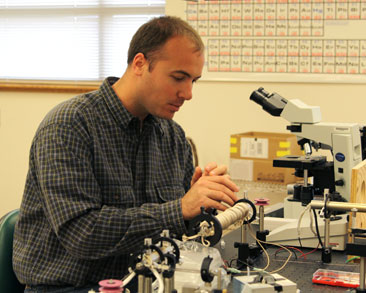Frostburg, Md. (November 3, 2010) – A new partnership among several regional institutions has established a high-tech laboratory in the Central Appalachians for using stable isotopes to study how past, present and future environmental changes influence terrestrial and aquatic ecosystems. With the opening of the Central Appalachians Stable Isotope Facility (CASIF) at the University of Maryland Center for Environmental Science Appalachian Laboratory, researchers now have access to a powerful tool for understanding how and when environmental change occurs.
AL researcher Dr. David Nelson prepares a sample for analysis at the Central Appalachians Stable Isotope Facility. |
In this growing field, researchers use an instrument called an isotope ratio mass spectrometer to determine the isotopic composition of samples of materials such as water, pollen, leaves and soils. Isotopes are different forms of the same chemical element that vary in the number of neutrons in their nucleus, which gives them slight differences in mass. For example, carbon has two stable isotopes: carbon-12 and carbon-13. Carbon-12 has 6 neutrons, whereas carbon-13 has 7. The mass spectrometer is capable of detecting these small differences in mass, which provides important information for studying changes to ecosystems over time.
Previously, scientists needed to travel hundreds of miles or ship their samples elsewhere for analysis. Now, thanks to a $434,000 research award from the National Science Foundation, area researchers have local access to a state-of-the-art isotope ratio mass spectrometer in Frostburg.
“With more than a dozen researchers from the Appalachian Laboratory (AL), Frostburg State University (FSU), West Virginia University (WVU) and the Canaan Valley Institute (CVI) currently conducting this type of research, establishing a regional facility in Frostburg makes a lot of sense,” said Appalachian Laboratory scientist and CASIF Director Dr. David Nelson. “Not only will this new facility help foster collaboration among scientists from across the area, it also will provide students the opportunity to learn about the environment with cutting-edge technology.”
While research programs vary by scientist, the facility will be instrumental in expanding regional research into landscape ecology, remote sensing, plant ecology and hydrology. The facility will help scientists better understand long-term variability in the flow of the Potomac River, how nitrogen availability impacts the growth of trees in the northeastern United States and how invasive species can alter stream ecosystems.
“My colleagues and I at WVU are thrilled to have this new instrument just down the road from Morgantown,” said Dr. Brenden McNeil from West Virginia University. “We have already begun using CASIF to analyze nitrogen isotopes in leaf samples to learn about how different trees influence nitrogen cycling in forests and we are looking forward to further growth in our research program thanks to this new facility.”
The University of Maryland Center for Environmental Science is the University System of Maryland’s environmental research institution. UMCES researchers are helping improve our scientific understanding of Maryland, the region and the world through five research centers – Chesapeake Biological Laboratory in Solomons, Appalachian Laboratory in Frostburg, Horn Point Laboratory in Cambridge, Institute of Marine and Environmental Technology in Baltimore, and the Maryland Sea Grant College in College Park.
# # #
Media Contact: David Nemazie, 443-496-0187
Related Link:


